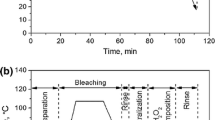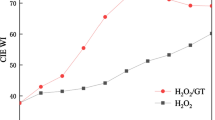Abstract
A screening experiment was designed to investigate the possible factors affecting the performance of activated peroxide systems (APSs) on bleaching of cotton fabric. The design of experiment comprised thirteen factors such as type of bleach activator (BA), concentration of bleach activator ([BA]), molar ratio of hydrogen peroxide to bleach activator ([H2O2]:[BA]), type of peroxide stabilizer (PS), concentration of peroxide stabilizer ([PS]), type of wetting agent (WA), concentration of wetting agent ([WA]), pH value of bleach bath (pH), bleaching temperature (T), bleaching time (t), liquor-to-goods ratio, cotton substrate (C), and water quality (W). The bleaching performance of APSs was accessed by measuring the degree of whiteness of bleached cotton fabric which was defined as the response factor for statistical analysis. The screening analysis revealed that C was the most significant factor affecting the performance of APSs on bleaching of cotton fabric, followed by T, BA, [BA], pH, PS, and [H2O2]:[BA]. Additionally, two-factor interactions were found as well between C and T, T and pH, C and BA, C and [BA], T and [BA], W and [PS], C and PS, and pH and [H2O2]:[BA]. These significant main effects and two-factor interactions were interpreted in details for a better understanding of the performance of APSs on bleaching of cotton fabric. The findings of this study are valuable for further establishment and optimization of APSs for low-temperature bleaching of cotton fabric.








Similar content being viewed by others
References
Cai JY, Evans DJ (2007) Guanidine derivatives used as peroxide activators for bleaching cellulosic textiles. Color Technol 123(2):115–118
Cai JY, Evans DJ, Smith SM (2001) Bleaching of natural fibers with TAED and NOBS activated peroxide systems. AATCC Rev 1(12):31–34
Daniel C (1959) Use of half-normal plots in interpreting factorial two-level experiments. Technometrics 1(4):311–341
Davies DM, Deary ME (1991) Kinetics of the hydrolysis and perhydrolysis of tetraacetylethylenediamine, a peroxide bleach activator. J Chem Soc Perkin Trans 2(10):1549–1552
El-Shafie A, Fouda MMG, Hashem M (2009) One-step process for bio-scouring and peracetic acid bleaching of cotton fabric. Carbohydr Polym 78(2):302–308
Gursoy NC, El-Shafei A, Hauser P, Hinks D (2004a) Cationic bleach activators for improving cotton bleaching. AATCC Rev 4(8):37–40
Gursoy NC, Lim SH, Hinks D, Hauser P (2004b) Evaluating hydrogen peroxide bleaching with cationic bleach activators in a cold pad-batch process. Text Res J 74(11):970–976
Hebeish A, Hashem M, Shaker N, Ramadan M, El-Sadek B, Hady MA (2009) New development for combined bioscouring and bleaching of cotton-based fabrics. Carbohydr Polym 78(4):961–972
Hofmann J, Just G, Pritzkow W, Schmidt H (1992) Bleaching activators and the mechanism of bleaching activation. J Prak Chem-Chem Ztg 334(4):293–297
Lee JJ, Hinks D, Lim SH, Hauser P (2010) Hydrolytic stability of a series of lactam-based cationic bleach activators and their impact on cellulose peroxide bleaching. Cellulose 17(3):671–678
Lenth RV (1989) Quick and easy analysis of unreplicated factorials. Technometrics 31(4):469–473
Lim SH, Gursoy NC, Hauser P, Hinks D (2004) Performance of a new cationic bleach activator on a hydrogen peroxide bleaching system. Color Technol 120(3):114–118
Lim SH, Lee JJ, Hinks D, Hauser P (2005) Bleaching of cotton with activated peroxide systems. Color Technol 121(2):89–95
Long X, Xu C, Du J, Fu S (2013) The TAED/H2O2/NaHCO3 system as an approach to low-temperature and near-neutral pH bleaching of cotton. Carbohydr Polym 95(1):107–113
Milne N (1998) Oxygen bleaching systems in domestic laundry. J Surfactants Deterg 1(2):253–261
Scarborough SJ, Mathews AJ (2000) Using T.A.E.D. in bleaching fiber blends to improve fiber quality. Text Chem Color Am Dyest Rep 32(3):33–37
Shao JZ, Huang Y, Wang ZH, Liu JQ (2010) Cold pad-batch bleaching of cotton fabrics with a TAED/H2O2 activating system. Color Technol 126(2):103–108
Wang J, Washington NM (2002) Hydrophobic bleach systems and textile preparation: a discontinuity in fabric care. AATCC Rev 2(6):21–24
Wang M, Long X, Du J, Sun C, Fu S, Xu C (2014) X-ray photoelectron spectroscopy analysis of cotton treated with the TBCC/H2O2/NaHCO3 system. Text Res J 84(20):2149–2156
Wu CFJ, Hamada M (2000) Experiments: planning, analysis, and parameter design optimization. Wiley, New York
Xu C, Shamey R, Hinks D (2010a) Activated peroxide bleaching of regenerated bamboo fiber using a butyrolactam-based cationic bleach activator. Cellulose 17(2):339–347
Xu CH, Hinks D, Shamey R (2010b) Bleaching cellulosic fibers via pre-sorption of N-[4-(triethylammoniomethyl)benzoyl]butyrolactam chloride. Cellulose 17(4):849–857
Xu C, Long X, Du J, Fu S (2013) A critical reinvestigation of the TAED-activated peroxide system for low-temperature bleaching of cotton. Carbohydr Polym 92(1):249–253
Xu C, Hinks D, Sun C, Wei Q (2015) Establishment of an activated peroxide system for low-temperature cotton bleaching using N-[4-(triethylammoniomethyl)benzoyl]butyrolactam chloride. Carbohydr Polym 119:71–77
Zeronian SH, Inglesby MK (1995) Bleaching of cellulose by hydrogen peroxide. Cellulose 2(4):265–272
Acknowledgments
This work was supported by the National Natural Science Foundation of China (Grant No. 21276106) and the Project for Jiangsu Scientific and Technological Innovation Team.
Author information
Authors and Affiliations
Corresponding author
Electronic supplementary material
Below is the link to the electronic supplementary material.
Rights and permissions
About this article
Cite this article
Fei, X., Yao, J., Du, J. et al. Analysis of factors affecting the performance of activated peroxide systems on bleaching of cotton fabric. Cellulose 22, 1379–1388 (2015). https://doi.org/10.1007/s10570-015-0550-1
Received:
Accepted:
Published:
Issue Date:
DOI: https://doi.org/10.1007/s10570-015-0550-1




